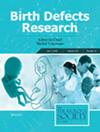To examine whether prenatal opioid use disorder (OUD) diagnosis is associated with the risk of congenital anomalies (CAs) in offspring.
We conducted a population-based study of mother–newborn dyads comprising.
4143 761 births delivered in Canada from 2006 to 2021. We used robust Poisson regression to examine the association between prenatal OUD diagnosis and risk of non-chromosomal CAs, adjusted for maternal age, parity, multiple gestation, co-morbidities (including mental health disorders, chronic illnesses and other substance use disorders), and infant sex.
We identified a total of 21, 638 births to persons who were diagnosed with prenatal OUD and 65, 992 (159.3 per 10,000) newborns with CAs. The overall risk of CAs was 2.3 times higher in infants born to birthing persons with a diagnosis of OUD (95% CI 2.2, 2.5). Compared to those without OUD diagnoses, births to persons with a diagnosis of OUD had a higher risk of specific types of congenital microcephaly (aRR 5.2, 95% CI 4.1, 6.6), cleft palate (RR 4.8, 95% CI 3.7, 6.1), pulmonary valve atresia with intact ventricular septum (aRR 2.7, 95% CI 1.1, 6.7), and atrial septal defect (aRR 3.1, 95% CI 2.8, 3.5), among others. In particular, infants born to those with an OUD diagnosis had a 1.8 (95% CI 1.4, 2.3)-fold increased risk of having severe congenital heart disease.
Our findings suggest an association between prenatal OUD diagnosis and certain CAs in the offspring. Future research is necessary to better understand the role of socio-demographic factors on these associations.


